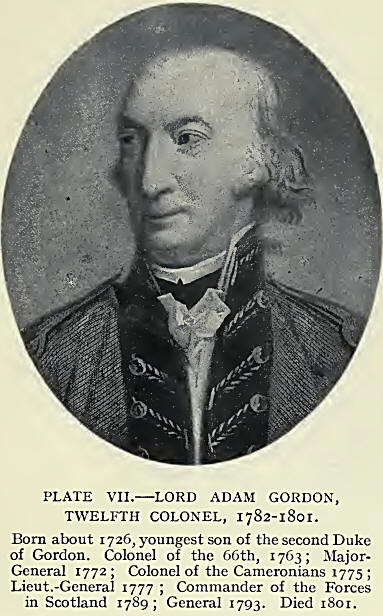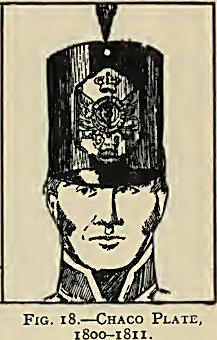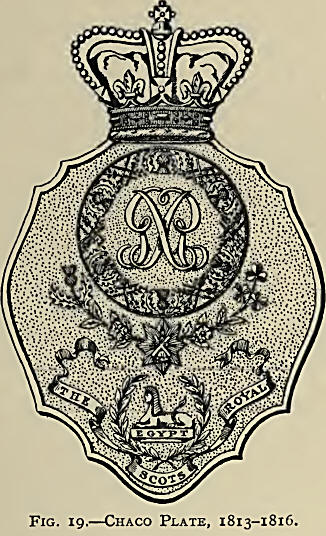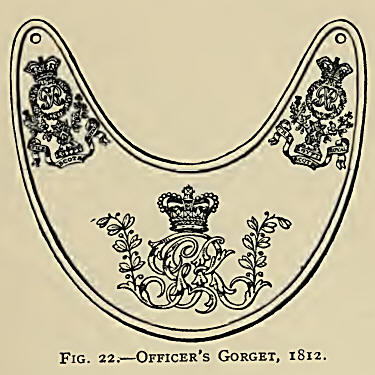|
Seizure of Island of St. Martin—Life in the West Indies—
Demerara and Berbice—St. Lucia—Depleted ranks— Service in India—Campaign
against the United States— Changes in uniform.
We must now return to the doings of the first battalion.
In February 1801 it sailed for the West Indies to : take part
in the expedition against the Swedish and Danish islands. Sweden and Denmark
had joined with Russia in an armed neutrality in the interests of France and
against England. Lt.-General Thomas Trigge was in chief command, and on
March 24 a landing on the Danish island of St. Martin was made successfully.
The Royals were to the fore, but the Governor showed more discretion than
valour, and after his surrender the battalion was divided. Six companies
remained there in garrison, and four went on to the capture of St. Thomas
and Santa Cruz. A home letter of this time from St. Martin’s, written by
Lieut. John Gordon of the regiment, gives a picture of life on these
colonial expeditions and shows that fighting was tempered by occasional
diversions—
"I intended to have written to you by last Packet, but a
sudden call to leave the island on business prevented me. I have now been
near three months in this country, and tho’ I cannot say I am much in love
with it, I think I shall stand the climate. We are fortunate in being
stationed in this island, which is one of the healthiest i$ the West Indies.
Some of the captured islands are quite the reverse, particularly St. Croix,
where the 64th Regiment, which came out along with us, has already lost
three officers, and upwards of 150 men. There is four companys of the Royal
detached at St. Thomas, and we have lost there two officers and 50 men; our
loss here is one officer and seventeen men. The officer we lost here went to
St. Thomas to pass a few days with his friends, and only lived one day after
his return. Tho’ this island be healthy, it is one of the hottest in the
country. The heat is so excessive, that we can scarcely stir out of the
house from nine o’clock in the morning till three in the afternoon. The
inhabitants here like the British Government and pay us every attention.
Colonel Nicholson of ours is Commandant of the Island, and the Council have
voted him £2,000 Sterling a year for his table. He gave a Ball and Supper on
the 4th inst., in honour of His Majesty’s birthday wnich cost him 300
guineas. It was known in the Island for several weeks that he was to give a
Ball on that day, and the Ladies, who are excessively fond of finery, were
at uncommon pains on this grand occasion. There was many dresses which I was
told (and from their appearance I don’t doubt it) cost upwards of £150
Sterling."
In August 1801 General Lord Adam Gordon died, and was
succeeded in the Colonelcy of The Royal Regiment by his Royal Highness the
Duke of Kent, from the 7th Royal Fusiliers.
A return dated 1802 shows that of 1290 men in the battalion
223 were “convicts, culprits, and deserters.” Many of these, doubtless, were
Irish rebels, good fighting material, but an awkward team to drive. The West
Indian captures did not long remain British, for by the Treaty of Amiens
they were restored to their original owners. Some of The Royals were moved
to Antigua. Others were quartered at St. Kitts in 1803, when war broke out
again in July.

In September, 650 of The Royals, with other troops, went on
an expedition against the Batavian Republic in South America. There was no
fighting, for Essequibo, Demerara, and Berbice surrendered, and in 1804
Major Hardyman was complimented on his skill in getting the Dutch prisoners
to enlist on the British side.
From 1805 to 1812 the first battalion was on garrison duty at
various West Indian stations and at Demerara and Berbice, varied by
occasional fighting, but not of sufficient importance to merit detailed
description.
Meanwhile, the second battalion had gone, in 1803, to the
West Indies with the expedition against the French island of St. Lucia. The
Royals led a Fig. 16.—Private’s gallant assault with the Sixty-fourth
against the strong post of Morne Fortunee, and carried it with the bayonet.
The pluck of one officer deserves especial mention. Captain Johnstone, who
had already been wounded in Holland and in Egypt, owing tc his lameness from
the last-mentioned wound, was carried at the head of the light company and
literally thrown into the fort, which he was the second man to enter. The
Royals altogether did so well that the King added “St. Lucia” to the Colours.
The island of Tobago surrendered without fighting in July. They remained on
garrison duty in Tobago and Dominica during 1804, and there and in other
islands in 1805, where they met some of the first battalion. They were back
in England by January of 1806, their ranks tragically depleted; indeed the
strength was returned as “1 rank and file fit, 53 sick, 30 on command,
704 wanting.” The deficiencies were partly made up during 1806 from their
own third and fourth battalions (of which more hereafter), and from other
regiments. The latter source shows that the First Foot were popular.
Early in 1807 grave difficulty arose with the Sepoys in the
service of the East India Company, and the spirit of insubordination was
rife throughout India. The second battalion was ordered to embark, and
filled its ranks from the third and fourth battalions. The voyage was long
and trying, and the story is set out in a journal kept by the Fife-Major of
the regiment, who was on board the transport Coutts. There was great
scarcity of water, and in consequence much sickness. They had been five
months afloat when The Royals landed at Penang, or Prince of Wales Island,
on September 18, for their first Indian service. The barracks were temporary
sheds, lightly built of stakes covered with cocoanut leaves. As the diarist
picturesquely says: “When it came to blow hard, the barracks had the
appearance of waving corn in harvest.” Beds there were none, and the buffalo
beef and rice was very sorry fare, which made the soldiers “long for the
flesh pots of that land we had left.”
The Grenadier company, which had sailed in the Surat
Castle, had an even longer and more eventful voyage. The ship was so leaky
that she parted with the main fleet, and if the Grenadiers had not worked
the pumps night and day as she made for Rio Janeiro she would certainly have
gone down. Presumably the exercise was useful, for they had little sickness,
but one was struck down by a thunderbolt, and another killed by the natives
of an island where they touched for soft water. On this latter adventure,
the landing party only got back to the boat by the skin of its teeth. Many
of them were a good deal battered in the retreat, and some remained on shore
as prisoners of the natives. This did not please The Royal Scots, so they
landed again fully armed and marched to the town where the King lived. The
natives did not like the look of them, and there was no opposition until
they got into the presence of his Majesty. One of them, named John Love,
then took the trembling Nabob by the neck and shook him like a rat. At this
point the royal suite made prudent haste to restore the prisoners to their
angry messmates, and so all returned on board in great content. By the end
of the year, six hundred and thirty-one of the regiment were at Madras, and
three hundred and forty-one at Penang, where many died of disease. By the
following February, the adventurous Grenadiers arrived and joined the rest
of the battalion at Wallajahabad, but the climate started to make short work
of the whole regiment, and they sought salvation by going to the sea at
Sadras. By that time they could only muster five hundred effectives, and in
the first day’s march three hundred of these fell sick, chiefly of brain
fever. This was going from bad to worse, so they turned tail and marched
back to Wallajahabad, carrying with them a hundred and fifty men who were
unable to march.

The sergeant who has already been quoted was also careful to
set down how the spiritual needs of the battalion were met. “We had prayers
read for the first time since we came to this country, by the Adjutant, who
had fifty pagados a month for doing the duty of chaplain. But this was, I
think, little short of making a mock of the divine ordinance, for here was
truly ‘like people, like priest.'"
It is to be hoped that the Adjutant was, in a more recent
phrase, “an ecclesiastically-minded layman,’’ because the return of births
shows it was part of his duty to baptize all the children born in the
regiment. In any case, it is clear that the adjutancy of The Royal Scots was
no sinecure.
The battalion was in garrison and on campaign at various
places in India from 1809 to 1816, but saw very little active service during
this period. That does not mean that they had an easy time. The constant
moves were trying work, as the roads through the jungles were no more than
rough tracks, and rations were very irregular both in quality and quantity.
The troops always travelled barefoot, because no shoes were obtainable and
the tracks were sand or puddles, and a march of sixteen miles would often
take nine hours. There was some excitement during 1811, when the battalion
was quartered at Masulipatam. There were murders and suicides by men who had
run amok, and a still less pleasant incident was a plot engineered by the
Roman Catholic privates against their Protestant comrades, which, however,
was discovered before mischief was done. At this time only about thirty per
cent, of the men were Scots as against about fifty per cent. Irish, and the
rest English. The year 1812 brought a slight diversion, when four companies
were sent to Quilon, in Travancore, to suppress a mutiny amongst the
Company’s native troops. The year 1816 was the last of comparative quiet,
but the second battalion’s exploits in 1817 must be dealt with in chapter
XV.

We now return to the doings of the first battalion. The
strong sympathy between France and the United States, and the help which the
States rendered to Napoleon in carrying out his policy of destroying British
commerce, led to a state of war between Great Britain and the States in
1812. The first battalion of The Royals was ordered to proceed to Quebec
from Demerara and the West Indian islands over which it was scattered. At an
inspection which took place in June, it was clear that the battalion was not
in good fettle for active service. It contained three hundred of the rawest
recruits, and two hundred and twenty-six privates were on the sick list.
Discipline cannot have been of the best, for the inspecting general found
that there had been a hundred and fifty-three courts-martial. This is hardly
to be wondered at, for there was much opportunity for racial bickering. The
battalion was now Scots only in name, for of the total strength of twelve
hundred, five hundred and five were Irish, three hundred and fifty-two
English, and fifty-six foreigners. They set out for Canada in seven
transports, but one of them, the Samuel and Sarah, carrying three officers
and a hundred and fifty-six rank and file, was captured by an American
privateer. The report of the master of the ship, one Samuel Sower, has
survived. When the enemy frigate approached, the mate who kept the watch
thought it was the ship of the commodore of the escorting British squadron.
When its captain invited Sower to heave to, he replied that he must first
signal to his commodore. To this the Yankee answered that any such
proceeding would result in a broadside which would sink the transport. Sower
then consulted with Lieut. Hopkins, who was in command of The Royal Scots,
and, as they agreed that the smallest signal or resistance would be attended
with great slaughter, they yielded the ship as a prize. The American captain
stipulated that the whole of the arms and ammunition should be given up, and
that the troops should give their parole not to serve against the United
States unless regularly exchanged, but the officers were to retain their
swords. Master Sower had to ransom his ship by giving bills for twelve
thousand dollars, but, that done, they were allowed to proceed to Halifax.
By September, their parole was cancelled by the exchange of the crew of a
captured Yankee ship.
The rest of the year was taken up with marching and
counter-marching, but there was no fighting.
In January 1813 the battalion was divided between Montreal
and Quebec, and its composition was again exercising the minds of the
headquarters staff. Lt.-General George Provost wrote to the
Commander-in-Chief about the great number of Frenchmen serving in the
regiment. He considered them “a very improper class of soldiers to serve in
Canada, where the French language was so generally spoken, and the habits
and manners of the mass of the population assimilates the French.” In May, a
small detachment of the battalion was engaged in the attack on Sackett’s
Harbour, and in the following month two companies seized a strong post
occupied by the Americans at Sodus, where a quantity of stores was captured.
Four companies of the battalion then enjoyed a change of service, for they
were embarked on board the fleet to serve as marines. From July to October
the rest of the battalion was busy with skirmishing engagements, and in
December the Grenadier company assisted in the storming and capture of Fort
Niagara. They sustained no loss, but it was a brilliant bit of work and won
them high praise. After this success five companies crossed the Niagara
river and were employed on December 29 in storming the enemy batteries at
Black Rock and Buffalo. This time they did not escape so easily, for they
had fifty-one casualties, mostly incurred while they were landing from batteaux under
a heavy fire. Their courage and skill in these operations is the more
notable when it is remembered that they were carried out in the rigours of a
Canadian winter and without any of the comforts which soften such work for
modern armies.
Early in 1814 the battalion was posted on the enemy’s
frontier, but they did not get to close quarters until the beginning of
March. A strong body of Americans was then posted at Long Wood, near
Delaware town, well fortified on a hill and protected by timber breastworks.
The light companies of The Royals and of the Eighty-ninth (now merged in
Princess Victoria’s Royal Irish Fusiliers) made a frontal attack in a most
gallant manner, while some *other detachments attempted flanking movements,
but unfortunately they had to retire without dislodging the enemy. No more
success attended a severe engagement on July 5, in which The Royals lost
seventy-eight killed and a great many more wounded. This reverse was
followed by the surrender to the enemy of Fort Erie. None of The Royals,
however, was in the garrison, and they returned to Fort George at the end of
July. They took part in the violent engagements near the Falls of Niagara,
when the British division under Lieut.-General Drummond, himself an old
Royal Scot, was attacked by the Americans. Drummond’s official report of the
engagement is full of praise for The Royals, who behaved with perfect
steadiness and intrepid gallantry, and excited his warmest admiration. Still
better, the enemy’s attack was repulsed and his retreat considerably
harassed. The distinguished bravery then shown was rewarded by the royal
permission to bear Niagara on the colours of the regiment. In August the
British attacked Fort Erie, but with no success, and eight companies of The
Royals carried out with great steadiness the trying duty of covering the
retreat. In September the enemy made a sortie, and it was largely owing to
the fine performances of the regiment that it was driven back, but at the
cost of the life of Lt.-Colonel Gordon.
In January 1815 the battalion left Fort Niagara for Queenston,
and later for Quebec, but peace soon followed with the United States, and
they sailed for England in July.
About eighty years afterwards, on July 25, 1893, the remains
of three soldiers of The Royal Scots, found on a farm near Niagara, were
reburied with fitting solemnity at Lundy’s Lane, when Canon Houston, in an
eloquent address, rehearsed the gallant deeds of the heroic Scots.
The beginning of the century saw a great change in the
uniform of the army. In the year 1800 the time-honoured cocked hat was
discarded in favour of a cylindrical chaco of lacquered felt with a leather
peak and an upright tuft or plume. On the chaco was fixed a thin brass
plate. This applied not only to the battalion and light companies, but also
to the Grenadier company when not wearing the bear-skin cap (see Fig. 15).
Side views of the privates’ and officers’ chacos are shown in Figs. 16 and
17, and of the chaco plate in Fig. 18.
When the title of the regiment was changed early in 1812, to
“The Royal Scots,” the new chaco was furnished with a plate, illustrated in
Fig. 19, with the Sphinx to commemorate the Egyptian campaign. The pattern
of belt-plate established in 1800 seems to have lasted until 1816 (Fig. 20).
There are two especial points of interest in the arming of
The Royals during this period. In May 1796 an order was issued directing
that officers’ swords should be straight and made to cut and thrust, but the
regiment certainly did not conform with this, as the sword used had a blade
of the Andrea Ferrara pattern (Fig. 21). It is possible that this type was
used by officers in The Royals before 1796, but it is clear that during the
Peninsular War the regimental sword was unique in the British Army. In 1812
also The Royals wore a gorget, the last decorative survival of defensive
armour, which was distinguished from that used by other regiments by reason
of the ornaments being “laid on” instead of engraved (Fig. 22).
 |

